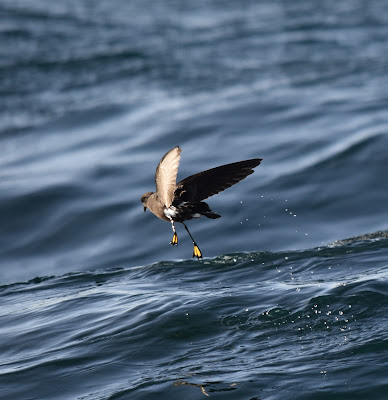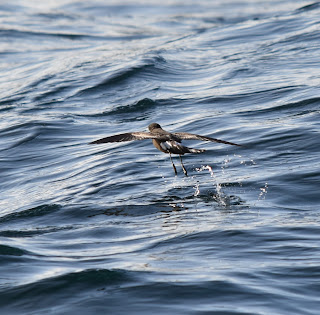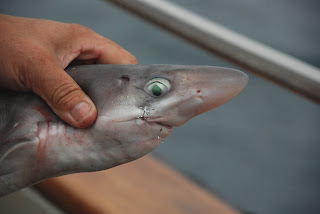The natural history exploits of Ross Newham - and the ultimate cure for insomnia!
Monday, 28 September 2020
Devil's-bit Scabious at Hothfield Common
Friday, 25 September 2020
Wilson's Petrels off Scilly: with thanks to Adrian Wander
There can be fewer images that have inspired me more than Adrian Wander's image of a Wilson's Petrel, taken in Aug 1993, that rightly won the British Birds 1994 Carl Zeiss Award. The image of the Suffolk MacQueen's Bustard (Houbara, as was...), photographed by Eric Hosking in 1962, or the Spurn Tengmalm's Owl of 1983, both stick in my mind - but Adrian's Wilson Petrel really inspired me. Far out to sea, he managed not only to see a Wilson's and get a great trip-snap, but as the BB article read, "Dr Adrian Wander's photographs of Wilson's Storm-petrel in flight about 60 km SSW of Bishop Rock showed not only the species' plumage and jizz, but also—astonishingly—the yellow patches on the webbed feet, a diagnostic feature difficult enough to see let alone photograph." A common seabird on its Antarctic breeding rounds, but a mega-rare seabird off UK coastal waters. Every time I saw Adrian's picture, I thought, "One day...".
 |
| Wilson's Petrel, Dr Adrian Wander, Aug 1993 off Scilly (by quite a few miles) and winner of the British Birds 1994 Carl Zeiss Award. Copyright: Dr Adrian Wander. |
...One day, I hoped to emulate something half a good as Adrian's picture... My initial sighting's of Wilson's Petrel thus far had been on the RMV Scillonian III: rather distant, given the height of the boat and the size of the bird (they weigh a rather slight 30g on average, which is the same as your average House Sparrow), and certainly any snaps I took at the time could easily be mistaken for specks of mud on my camera's mirror...
In recent years I have been fortunate enough to have an occasional July or August holiday on Scilly - and that has afforded me the opportunity to head out with Joe Pender, aboard the MV Sapphire, and see brilliant seabirds at super-close range. Amongst many other pelagic species, Wilson's Petrels have been a regular feature of these evening trips - Bob Flood, of Scilly Pelagics fame, usually being first to pick out this South Atlantic-breeding rarity to UK waters, amongst tens or even hundreds of similar, but relatively local, Storm Petrels. Sightings of seabirds, whilst aboard the MV Sapphire, are brilliant - you are in their environment and the seabirds couldn't care less. Indeed, with the stink of Joe's putrefying fish chum drifting with the wind, the seabirds are most definitely attracted towards the observer.
This year, finally, my Adrian Wander and Wilson's Petrel stars finally aligned... On the 27 July, Joe and Bob took us out in to the stiff breeze and on to some lumpy waters. With the bag of chum tied up and dragging alongside the Sapphire, the birds started arriving... A superb evening with seven tubenoses safely 'in the can'. And finally, finally, finally, I was able get the 'Wander' picture, I had longed for.
For any sad non-birders still reading this far down this blog entry, you clearly need extra medication to help you nod off. For any birders still awake, the following are 'my' Wilson's from that night. None of them will win the British Birds 2021 Carl Zeiss Award - they'd be too similar to that winner of the 1994 award. However, to me, and unknown to the other observers that night, these pictures are a personal odyssey finally reached - and a lot of pleasure it has been!
Thanks to Adrian and Joe and Bob... for all their contributions (not that any of them knew it) to this fun little 26-year odyssey of mine.




Foot note: Adrian - it would be good to see you off Scilly one summer soon!
Wednesday, 9 September 2020
Rare Dragons in the Lake... Lessor Emperor - Leybourne Lakes Country Park (11 Aug 2020)
New dragonfly species are few and far between for me these days and the list of species I haven't seen in the UK (of those that have occurred) is down to one native species (Northern Emerald), a few regular or recent colonists (Red-veined Darter, Dainty Damselfly and lessor Emperor) and then a whole heap of the super-rare species.
I tried to see Northern Emerald in NE Scotland one summer and, in the process, submerged myself up to knackers in boggy-peat water when I trod on what I thought was firm land - it turned out I had attempted to walk on water, and I couldn't. Trousers and footwear removed, all was well until I needed fuel in Aberdeen and promptly had to fill the car with petrel whilst dressed only in my boxer-shorts. Standing there like a Wally with my petrel-pump in hand, I thought all was well until several hundred pedestrians walked on to the petrel station forecourt, fresh from leaving an Elton John concert nearby...
Red-veined Darter has officially given me the slip on several occasions - and I haven't been 100% of a couple of my own sightings. But they are relatively common for an uncommon species (John has seen them..), so I have little doubt I'll see one soon.
A colony of Dainty Damselflies was found in 2009/10 under the new bridge that takes criminals back over to the Isle of Sheppey. They were seen for a few years, and are possible even still there, but my two half-arsed attempts were fruitless (or even damselflyless...). But John Clements saw them, so they can't have been too difficult to see... Alas, all I can do is wait for another colony to be found (which it now has - at Sandwich Bay BO).
I had tried for Lesser Emperor a couple of times, once near Cambridge whilst returning from a work trip and a second time at Dungeness - unfortunately, on both occasions either the weather or observer incompetence intervened and I failed in my quest. But, no bother, I'd find one sooner or later - wouldn't I? After all, John Clements has seen them...
My wait to find my own Lesser Emperor ended on 11 Aug, within 10 metres of the house, at Leybourne Lakes Country Park. Sitting on a bench, overlooking the lake, on 10 Aug I thought I saw a blue waistband on a large dragonfly - but then, no further sightings. With only a little more effort the following day I finally relocated my quarry - a rather spectacular Lesser Emperor.
The beastie spent much of the day quartering the nearby patch of dead willow tree in the lake and settling there on several occasions when the conditions warranted such lazy activity...
A Vagrant Emperor (44) last November and now Lesser Emperor (45)...what will my next species of Odonata in the UK be? Dainty Damselfly, surely?
Monday, 7 September 2020
'By-the-wind Sailors' - One of nature's beauties, off the Isles of Scilly
 |
| 'By-the-wind Sailor' - dead but floating... |
 |
| 'By-the-wind Sailors' - dead and paddle boarding...! |
Velella is a monospecific genus of hydrozoa in the Porpitidae family. Its only known species is Velella velella, a cosmopolitan free-floating hydrozoan that lives on the surface of the open ocean. It is commonly known by the names sea raft, by-the-wind sailor, purple sail, little sail, or simply Velella.
This small cnidarian is part of a specialised ocean surface community that includes the better-known cnidarian siphonophore, the Portuguese man o' war.
Each apparent individual is a hydroid colony, and most are less than about 7 cm long. They are usually deep blue in colour, but their most obvious feature is a small stiff sail that catches the wind and propels them over the surface of the sea. However Velella sails always align along the direction of the wind where the sail may act as an aerofoil so that the animals tend to sail downwind at a small angle to the wind.[5] Having no means of locomotion other than its sail, V. velella is at the mercy of prevailing winds for moving around the seas, and are thereby also subject to mass-strandings on beaches throughout the world.
Sunday, 6 September 2020
Shark Encounters with Scilly Pelagics

The fun of heading out a few miles off Scilly to see seabirds every few years, should be enough to lure fellow enthusiasts (or nutters as some non-birders may refer them) out on to the open waves. But...like much of watching nature, there is no guarantee a rare seabird on every trip - and if there was, it wouldn't be quite as much fun - honest guv!



 The Blue Sharks tagged off Scilly are helping ecologists gain ever greater knowledge about this beautiful beasts - and armed with greater knowledge, we can do more to help preserve numbers for the benefit of a healthy ecosystem.
The Blue Sharks tagged off Scilly are helping ecologists gain ever greater knowledge about this beautiful beasts - and armed with greater knowledge, we can do more to help preserve numbers for the benefit of a healthy ecosystem.
The second most common species attracted to the chum, is the Porbeagle Shark - whilst the Blue Shark in sleek and elegant, the Porbeable Shark is a mean-looking member of the 'Mackerel Shark' group. The Mackerel Sharks are also known as the white sharks and they include within their group, the most famous of them all, the Great White. Our Porbeagle is common around UK waters and those that wander off-shore are also occasionally caught and tagged as part of the tag and release projects mentioned above.
The third species of the shark family that I've seen pulled out, has been the Spurdog. Not quite the formidable beast that is the Porbeagle, the Spurdog is, none the less, as very sleek looking member of the wider shark family. The one photographed below was caught off Scilly in August 2018.
All of these beasts have been sent on their merry way - free to roam the underwater routes that take them round our seas. Their brief visit in to our world has been an exciting addition to fantastic trips off Scilly with Joe Pender, aboard the Sapphire, as part of the trips out that Joe and 'Scilly Pelagics' offer to those wanting to see something new and something very special.





















